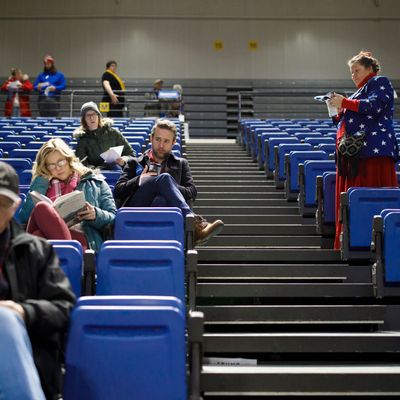
On the occasion of my third round of Iowa caucuses (as an observer), I took the advice of the Des Moines Register and went to Drake University’s Knapp Center, where Des Moines precinct No. 62 gathered to make an impact on the 2020 Democratic presidential contest:
A precinct to watch is Des Moines’s 62nd, a large area that includes parts of the Waterbury, Ingersoll Park, Westwood and Linden Heights neighborhoods, where local party leaders, activists and donors are concentrated. That makes it a bellwether for candidates’ support among some of Iowa’s most engaged Democrats.
It is a more comfortable if less intimate setting than in past caucuses where participants milled around and observers like me stood in a corner. Here at the Knapp Center (Drake’s basketball arena), caucusgoers were directed to their candidate-preference seating areas from the get-go, while us media types were sequestered behind the two goals, hoping that either the alignment numbers would be announced or that we could quickly count them from the sections they occupy.
I was fortunate enough to be seated (by pure serendipity) next to longtime Register columnist Rekha Basu, who helped me understand the setup. A few minutes before 7 p.m., the precinct czars warned participants that registration would begin exactly at the appointed time (“We’re starting the show here pretty quick”). Preference-group seating was selected based on the most recent published Iowa poll (taken in early January,) so Sanders and Warren had the largest areas, though they were not yet even close to full.
While waiting for everyone who was in line for registration at the witching hour to sit down, the precinct chair asked for a show of hands of first-time caucusgoers, and it was notable that two-thirds of those in Bernie’s section responded affirmatively. It’s a good sign for his campaign’s efforts to build a big turnout based on his strong appeal to millennials.
Two U.S. Senate candidates (Theresa Greenfield and Emily Graham) were given the opportunity to speak to this influential gathering of activists.
The counting process is elaborate but transparent. The preference groups were been told to bunch up and eliminate empty seats in their areas. It quickly looked like as though five candidates could exceed the 15 percent viability threshold in the first round (Warren, Buttigieg, Biden, Klobuchar, and Sanders).
The total attendance count was at 827, which made the viability threshold 127. And yes, once the first preferences were counted, five candidates demonstrated viability, in this order:
Warren 212
Buttigieg 172
Klobuchar 141
Biden 131
Sanders 129
’Twas a very near thing for the two late-septuagenarians who have been dominating the national race recently.
About 100 caucusgoers in this precinct were deemed members of “unviable groups”; 28 with them were members of the Yang Gang; 26 were for Tom Steyer; and 6 were for Tulsi Gabbard. These up-for-grabs caucusgoers were asked to separate themselves, and the viable campaigns vying for their support were given 15 minutes to pull them over — and a microphone to make speeches duly given.
The final count was as follows:
Warren 227 (15 realigned)
Buttigieg 194 (22 realigned)
Klobuchar 149 (9 realigned)
Biden 138 (7 realigned)
Sanders 134 (5 realigned)
I don’t know at this point how the candidates are doing statewide, but here the candidate generally expected to win finished fifth. Go figure.






























